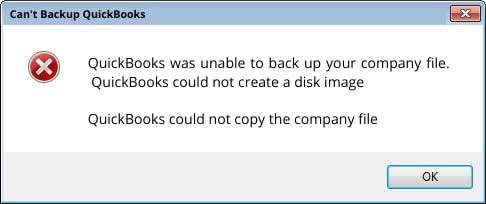Regular backups of any company data guarantee business continuity, reduce downtime and help in the prevention of data loss. One feature of QuickBooks is the ability to back up company files to an external or internal device. If the company files are accidentally deleted or become corrupted, this enables you to restore them with just a few clicks. This article helps you to understand the causes and resolve the QuickBooks backup failed issue. When you attempt to use the software backup features to backup company files (.QBW) data, the error QuickBooks unable to back up company files shows on your screen.
However, there are situations when taking a QuickBooks backup can result in errors like…

quickbooks won’t back up
Backup failed or QuickBooks is unable to backup company file or QuickBooks backup error- space availability
There are several other reasons for this problem, such as corrupted QBW files and damaged ND files.
Reasons for the QuickBooks Unable to Backup Company File
The “QuickBooks company backup failed” issue might have several main causes, which could endanger the data of your business. Let’s examine each of the underlying reasons one by one now that we’ve discussed them all in depth.
- Corrupt or damaged data in the corporate file(s).
- An incorrect backup route.
- If the media for backup storage is unavailable or not attached.
- QuickBooks is being blocked by an antivirus program or a firewall.
- There is not much more space on the shared disk.
- QuickBooks files are used by other software while doing backups.
Methods To Fix QuickBooks Backup Failed Issue
Things to remember before troubleshooting QuickBooks backup failure…
- First requirement: Make sure you have enough space on the disk where you intend to store the backup before moving on to the options. Make sure there is at least 1 GB of free space on any disk partition or external storage, depending on the size of the firm files.
- Second requirement: temporarily disable the antivirus or firewall software.
Scenario 1: QuickBooks Desktop Errors During Backup in Windows
First Method: Run Quickbooks File Doctor Tool
The QuickBooks File Doctor utility is intended to fix typical problems with corporate files in QuickBooks desktop. Nevertheless, QuickBooks Tool Hub must be installed on your computer for you to use this tool. To use the File Doctor Tool, let’s first download and install QuickBooks Tool Hub.
- First, choose Company File Issues from the QB Tool Hub’s menu.
- After selecting Run QuickBooks File Doctor, you may need to wait a minute or two for the program to appear.
- From the drop-down menu, choose your company file. Choose Browse and do a search to locate your file if it is not shown.
- A hit Once your file has been checked (use the middle option alone), click Continue.
- Finally, select Next to finish after entering your QuickBooks admin password.
- Attempt to make a backup of the company file now. Proceed to the next solution if you continue to fail.
Note: Look for QuickBooks Desktop File Doc and open it manually if, even after a few minutes, the tool still won't open.Second Method: Check and Rebuild the Company Document
You can use the Verify and Rebuild tool to address any potential data damage you find in the business file. To restore the damaged data and make your company file functional, use the Verify tool to first identify the damage and then the Rebuild tool to rebuild it. As you follow the comprehensive instructions below, let’s run the tool.
Check the Data in the Company File
- After pressing the Window button, choose Close All.
- Select Utilities after choosing the File tab.
- Additionally, select Verify Data if you see the following menu items:
- QuickBooks did not identify any problems with the information you gave. There is nothing else you need to do because it is obvious that there is no data harm.
- You may search our database for ways to solve that problem, according to the error message that displays on the screen.
- It states unequivocally that data loss was discovered in the business file and that you need to use the rebuild tool to fix it. “Your data has lost integrity.”
Rebuild the data in the company file
- Select Rebuild Data after selecting Utilities on the File tab.
- QuickBooks will prompt you to establish a backup since doing so is necessary before recreating the company data; click OK.
- After you’ve decided where you want to save the backup, click OK.
- Not replacing another backup file is another important reminder. To accomplish this, change the file name in the designated field and click Save to proceed.
- Once the screen indicates that the “Rebuild has been completed,” choose OK.
- Return to the File tab now, choose Utilities, and then click Verify Data to see if there is any further harm.
- Should the Verify tool identify more damage in the company file and provide you with a particular problem number, you will need to manually repair it by looking up the same information in our database.
- You can use a recent backup to restore the business file, though, if the problem cannot be located.
- Navigate to File and choose between Opening or Restoring Company.
- Proceed to the next option if the “QuickBooks local backup failed” problem cannot be resolved by using the Verify and Rebuild tool.
Third Method: Check QBDT for the Backup Directory
This phase will verify if QuickBooks has a legitimate path for the backup file to be created. Let us proceed as described in detail below.
- Once QuickBooks is open, pick Edit > Preferences.
- Verify the backup directory you’ve chosen and make sure QuickBooks has a legitimate path for the backup file.
- Go to the next solution if this one doesn’t work.
Fourth Method: Change the file’s name to .ND
The “QuickBooks local backup failed” problem might be brought on by a corrupted or damaged .ND file. So let’s get started by going over the specific procedures listed below to discover how to rename the .ND file.
- By hitting Windows + E, you may exit QBDT and launch the Windows File Manager.
- To locate the network data file, go to C:\Users\Public\Public Documents\ Intuit\QuickBooks. Recall that the file has the same name as your corporate file, but it ends in.ND.
- Select Rename with a right-click on the file, then click Add.Add OLDFILE to the end of the file name, then save the modifications.
- Attempt to make a backup of the company file once more.
Scenario 2: QuickBooks Backup has Failed on MAC
For Mac, let’s examine the solutions and apply them in the specified sequence to get the greatest outcomes.
Method 1: Upgrade to the most recent version of QBDT for Mac
Keeping QuickBooks for Mac up to date with the most recent release guarantees that you always have access to the newest features and bug patches required to remedy frequent problems. Let’s update the program by taking the actions listed below.
- Go to the QuickBooks drop-down menu and choose Check for Updates.
- If the most recent version is available, choose Install Update after that.
- Choose Install and Relaunch in addition. QuickBooks will launch automatically when the upgrade is finished.
If the “QuickBooks backup failed” problem is not resolved by upgrading QuickBooks for Mac, go to the next fix.
Method 2: Utilize the Rebuild and Verify Tool
Data corruption in the business file may be repaired using the Verify and Rebuild tool. Let’s run the tool by going through the simple procedures listed below.
- Select Utilities and then Rebuild Data after opening your company file and going to the File menu.
- Select OK from the QuickBooks Information pop-up menu.
- Click OK after the fix has been completed.
- Moreover, go back to the File menu, pick Utilities, and last click Verify Data.
- If QuickBooks detects no issues with the company file, click OK. In the event that it does identify problems, choose Rebuild Now.
- To see whether the QuickBooks backup still fails, try making a backup of the company file now. If it does, go to the next solution.
Method 3: Using an Example Company File, Make a Backup Copy
Try to make a backup copy of a company file that you use as an example in QuickBooks. If it functions, you might want to recreate your business file. The NO COMPANY OPEN Window may be used to produce an example file, as seen below.
- Navigate to the File menu, then choose Close Company to open an example file.
- Next, pick an example company to open by clicking the drop-down arrow on the Open a sample file tab.
- Lastly, select an example file and launch it.
- Create a new user admin account and continue on to the next alternative if this one also fails.
Method 4: On Your Mac Computer, Make a New Admin User
This is to make sure no system problems are preventing the program from backing up your data. Let us see how to establish an alternate admin user by following the procedures listed below.
- Click Users & Groups after opening System Preferences from the Applications folder.
- After selecting the Lock icon and entering your password, click OK to proceed.
- Furthermore, click the addition (+) icon that is situated beneath the user account list.
- From the list of available account types, select Administrator.
- After providing the necessary information, click Create User to finish.
- Try again with a different admin account to build a backup of the business file and see whether the problem has been fixed. Proceed to the next troubleshooting step if the QuickBooks backup fails.
Method 5: Take Into Account Delete Plist Files
This part will teach us how to remove Plist files and then attempt to restore the business file. Let’s carry out the actions listed in detail below.
- Shut off every open program, including QuickBooks.
- Next, select the Go menu and select Library while holding down the Option key.
- Double-click the Preferences folder to locate the files that include the mention of com.intuit.QuickBooks20XX.
- After putting the Plist files in the trash and restarting the computer, delete them.
- After finishing, make sure the Backup choice is set correctly by opening QuickBooks.
- If you are still unable to build a local backup in QuickBooks desktop, try creating a backup of the business file once again. Proceed to the next solution if you’re still unable to.
Scenario 3: If QuickBooks has Failed to Back with Intuit Data Protect
If the QuickBooks business file is not backed up by Intuit Data Protect, you can perform the following practical steps.
Method 1: Verify if Intuit Data Protect is being blocked by the Windows Firewall
Recall that Intuit Data Protect cannot be blocked by the Windows firewall. You may experience problems with backup failure if the firewall prohibits IDP. To make sure that crucial files are permitted to get past firewall constraints, let’s verify the firewall configuration.
1st Step: Include Important Files in the Windows Firewall
- In the search area, type “Firewall” after pressing the Windows Start button.
- Next, choose Allow another app >Allow an app over Windows Firewall.
- After choosing Browse, proceed to Program Files(x86)\Common Files\Intuit\Data Protect.
- Go to Network types>Private checkbox>Add after selecting QBIDPservice.exe>Open. For the files IntuitDataProtect.exe and IBUenghost.exe, repeat these steps. You are done if a notification appears stating that the files are already there.
2nd Step: Add Intuit Data Protect to the trusted Sites
- In the search bar, type “Internet options” after pressing the Windows Start button.
- Choose Trusted Sites after selecting Security.
- Add the following websites after choosing Sites. Keep in mind that you can manually input them or copy and paste them. For each site you want to add, click Add.
- backup.com
- *.intuit.net
- *.intuit.com
- *.intuitdataprotect.com
- *.quickbooks.com
- workplace.intuit.com
- emerald.backup.com (a fresh, reliable website that upgrades your certifications for Intuit Data Protect)
- Make sure that the Required server verification (https:) is not selected for any site inside this zone, then choose Close and click OK.
- Check now to see whether you can access the Intuit Data Protect certificate site. To be sure the problem has been fixed, you can also attempt to make a backup using Intuit Data Protect. Proceed to the next repair if not.
Method 2: Verify that IBuEngHost.exe is not operating as a Windows User
The file IBuEngHost.exe must be executed as the System user. This promotes the optimal operation of Intuit Data Protect. Let’s see if the file is operating as a System user by following the comprehensive instructions below.
- Choose the Start Task Manager option by performing a right-click on the Windows Taskbar.
- Select the Details tab next, and then search for the IBuEngHost.exe file. Verify that the User name is System and that the Status is Running.
Take the actions listed below if the IBuEngHost.exe file isn’t operating as a System user,
- First, store the QuickBooks installation file in a location that is convenient for you after downloading it.
- Choose Run as Administrator from the menu when you right-click the installation.
- Next, carry out the reinstallation, and once it’s done, check the Task Manager once more for the IBuEngHost.exe file. Make sure the System is the username and that the Status is Running as well.
- Check to see whether the “QuickBooks backup failed” issue still exists by attempting to create a backup again. If so, go on to the next fix.
Method 3: Update Intuit Data Protect and QuickBooks Desktop simultaneously
Let’s download and install the most recent versions of QBDT and IDP to make sure the backup problem is effectively fixed since QuickBooks was unable to back up your company file.
First, think about upgrading QBDT
To make sure that the company file backup procedure is not impacted by missing updates, the first step is to update QuickBooks Desktop.
Update the IntelliSafe Program
It’s crucial to update IDP since it guarantees the success of your backups. Installation instructions for the updates are provided below.
Get the most recent Intuit Data Protect Update
- Navigate to the Help menu; choose Update QuickBooks; next, choose the Update Now option.
- Next, choose Data Protect from the list, and after that, choose Get Updates.
Apply the update
- The up arrow ^ on the desktop toolbar should be selected first. It’s in the lower-right corner, next to the clock.
- Select About Intuit Data Protect from the menu that appears when you right-click the Intuit Data Protect icon.
- When it’s done, choose Update and click OK.
- Proceed to the next solution and attempt using the Diagnostic Tool if this one doesn’t work for you
Method 4: Utilize the Diagnostic Tool for Intuit Data Protect
For resolving the “QuickBooks backup failed” issue, the Intuit Data Protect Diagnostic tool is quite effective. It thoroughly examines the RAM, disk space, and Windows components on your PC, including the Intuit Data Protect version and the .NET Framework. Additionally, it examines your ability to establish a connection with the backup servers. Let’s use the tool by doing the following actions.
- To get More Information about Intuit Data Protect, right-click the green padlock icon that represents the program.
- To launch the Intuit Data Protect Diagnostic tool, press the keyboard shortcut Ctrl + F2.
- In the end, choose Run Diagnostics.
- An error popup will show up on the screen if the tool finds a problem. For instructions on how to manually fix it, go to the complete information.
Method 5: Make Space for Intuit Data Protect
Make sure you don’t use up all of your storage space to prevent backup failure. Intuit Data Protect backup space must be cleared if you do. Some of your stored data can be deleted in order to create a backup of fresh files and folders. Let’s take great note of the instructions below.
Verify the most recent version of Intuit Data Protect,
You must update the IDP to the most recent version before making any space available. The article above provides directions for doing the same.
Eliminate Backup Folders,
Recall that once you erase backed-up files or folders, you cannot get them back. Thus, in order to prevent data loss, make sure you download these files and directories. Another important thing to remember is that neither your computer nor the data are altered by Intuit Data Protect. Now let’s remove the files by following the instructions below.
- Choose Open Intuit Data Protect from the context menu when you right-click the Data Protect icon located in the Desktop screen’s system tray at the bottom right.
- To get a screen where you may remove backed-up files, use Ctrl + R.
- Data Protect will first calculate each folder’s size. Press Delete once it’s finished.
- To proceed, choose Yes to ensure that you really do want to remove the backup folder permanently, and then click OK.
Reduce Back File Size,
There could be a few pointless files that don’t require backing up. Try deleting such files using the instructions below to prevent going over your storage limit.
- To open Intuit Data Protect, right-click the Data Protect icon located in the system tray on the Desktop screen’s bottom right corner, and choose Open.
- Uncheck any files and folders you don’t need to back up when you select Change Backup Settings.
- Try creating a backup once again to see whether the problem has been fixed, then choose Continue until you exit Backup Settings.
Method 6: Add the ports of the Windows Firewall
We’ll learn how to add inbound port 80 and outbound ports 443 and 16841 to the Windows firewall configuration in this section. Due to their ability to link Intuit Data Protect to the Internet, these HTTP ports are crucial. Together, we can easily set up the firewall settings by following the steps shown below.
- In the search field, type Control Panel after clicking the Windows Start button.
- Select Advanced Settings after choosing Windows Firewall under System and Security.
- Additionally, under the Advanced Settings window’s left side, choose Inbound Rules. Select New Rule from the window’s right side after that.
- Click Next after entering the Outgoing Ports 443 and 16841 and the Incoming Port 80.
- Proceed with the on-screen instructions and then carry out the Outbound Rules steps 1 through 4 again.
- Proceed to the following solution if setting firewall ports does not resolve the “QuickBooks desktop backup failed” issue.
Method 7: Internet Explorer: Clear the Temporary Files, Cookies, Cache, and SSL Status
- Let’s see how to remove Temp files, cache cookies, and other items by following the comprehensive instructions below.
- Select Internet Options from the Tools menu after launching Internet Explorer.
- Navigate to the General tab and choose Delete… from the Browsing History section.
- Additionally, remove the checkboxes for Preserve Favorites and Website data after selecting the following ones: History, Form Data, Cookies and Website Data, Temporary Internet files and Website files, and InPrivate Filtering.
- To remove the items, select Delete. Then, select the Content tab.
- Choose Clear SSL status as the final option, then click OK.
Scenario 4: When QuickBooks Cannot backup to Network Drive
This section will cover how to resolve the “backup failed” error message while storing a backup to a network disk.
Activate My Program’s Quick Fix,
The Easy Remedies My program utility resolves QuickBooks general program problems. You may save the backup on your shared drive by using this crucial tool to resolve backup problems. The steps to run the tool are listed below.
- First, go to Tool Hub, pick Quick Fix my Program, then click Program Problems.
- Open your data file and restart QuickBooks Desktop.
Note: QuickFix My Program needs to be downloaded and installed on the computer first since it is a utility in QuickBooks utility Hub.Also see: Fix Error QuickBooks Application with Revoked Certificate
Frequently Asked Questions
Numerous factors, such as inadequate storage, firewall prohibitions, corrupted data, improper backup path, etc., might cause a QuickBooks backup to fail.
You can use the File Doctor program, to confirm and rebuild the business file, confirm the backup location, and rename the.ND file, and other standard troubleshooting techniques for Windows.
Maintaining a corporate file backup guarantees that your data is secure at all times. Should your corporate file experience corruption or data loss, you may always recover your data. As a result, maintaining a backup of firm files is crucial.
Free up space on your storage device or choose a different location with more available space for the backup. Ensure your backup file path leads to a destination with adequate storage.
Yes, if the file path is too long or leads to a restricted folder, QuickBooks may encounter problems backing up the file. Check the file path and ensure it directs to an accessible location.
Verify that the folder where you’re saving the backup has the appropriate read/write permissions. You may need to adjust the folder settings to allow QuickBooks access.
Yes, a corrupted or damaged company file can lead to backup errors. Use the QuickBooks Verify and Rebuild Data tool to repair the file before attempting the backup again.







